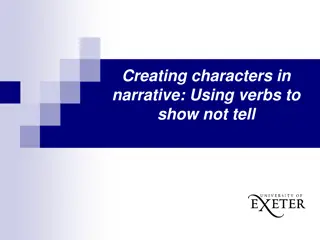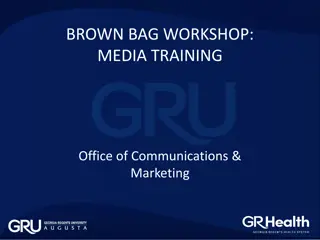Understanding Narrative Theory and Character Roles in Media Studies
Dive into the world of narrative theory and character roles in media studies, exploring the plot development, universal structures, and the significance of character types such as the hero, villain, donor, and more. Discover how these elements shape storytelling in various forms of media, from films to adverts, following the patterns identified by Propp in Russian folk stories to classic Hollywood cinema.
Download Presentation

Please find below an Image/Link to download the presentation.
The content on the website is provided AS IS for your information and personal use only. It may not be sold, licensed, or shared on other websites without obtaining consent from the author. Download presentation by click this link. If you encounter any issues during the download, it is possible that the publisher has removed the file from their server.
E N D
Presentation Transcript
GCSE MEDIA STUDIES N A R R ATI VE
THE PLOT: What happens. This is the story of the programme or advert, just like studying a novel, you will pick up on events and characters and development.
NARRATIVE THEORY PROPP claimed that stories and their structures are determined by the role of characters. He studied a wide range of Russian folk stories and identified 8 key roles:
CHARACTER ROLES/STOCK CHARACTERS the villain opposes the hero the donor (provider) helps the hero by providing a magic object The sidekick gives support to the hero the hero seeks something the princess the reward for the hero and needs to be protected from the villain the dispatcher send the hero on his way the false hero falsely assuming the role of the hero
UNIVERSAL STRUCTURE In terms of narrative driven by character type, Propp can be seen to have been influential in identifying a universal structure that can be applied to virtually all stories and in particular classic Hollywood cinema.
WHAT CHARACTER TYPE IS THIS? of this character. They are usually looking for something a quest, or trying to solve something a mystery. Usually they are the person we want to succeed in the story Generally this character leads the narrative. The story being told is the story
WHAT CHARACTER TYPE IS THIS? being morally bad. This turns the audience against him and drives them to support the hero. This character s lack of morals serves to highlight the goodness of the hero. This character may seek to prevent the hero from achieving the goal or may seek the same object as the hero This character struggles against the hero. This character is typically shown as
WHAT CHARACTER TYPE IS THIS? deliberately sought by the hero, perhaps rescuing them from the villain. Secondly he/she may be the reward after the hero has completed the mission or achieve the goal. This character may be seen very little in the story or may be an important character that we see often and could accompany the hero on their mission. This character may take two forms. First he/she may be the object which is
WHAT CHARACTER TYPE IS THIS? magical weapon, or a clue, or a special power etc. This gift enables the hero to complete their quest. This role may be combined with that of a helper. This character is a person who gives the hero something special such as a This character may not give up their gift without setting the hero another task, from a simple riddle to another quest.
WHAT CHARACTER TYPE IS THIS? moments to provide support. This character is involved in a supporting role, assisting the hero throughout the story. Often this character has a character flaw that the hero has so it helps to highlight this quality in the hero e.g. intelligence, determination, courage etc. The hero is supported in their quest by this character, who appears at critical
WHAT CHARACTER TYPE IS THIS? persuade as they have protective character traits. This character may also be older and a figure of wisdom. He is a difficult character to define in modern stories and will often not be present or his role could be combined with another character type. This character gives the task to the hero. He is a key figure for the hero to
WHAT CHARACTER TYPE IS THIS? the hero. This character will try to steal the hero's thunder, grabbing the credit and perhaps try to marry the princess. This character will often gain the respect of other characters, especially the princess s father thus frustrating the hero s ability to gain the hand of the princess This character appears to act heroically and may even be initially mistaken for
WHAT CHARACTER TYPE IS THIS? the mission. Sometimes this character can also be the princess s father and will give the hero a set of quests to complete. This character can also be combined with the false hero who then follows along behind the hero. An early role in the story is that of this character. They will send the hero on
TZVETAN TODOROV TzvetanTodorov, in his book The Fantastic outlines several stages that a plot works through: 1. A state of equilibrium 2. A disruption of the equilibrium 3. A recognition of the disruption 4. Attempt to repair the disruption 5. Restatement of the (new) equilibrium Godalming College Media/Film Studies 15
TASK Complete the Top Trumps Tasksheet
TASK In small groups you must come up with a film idea which will appeal to your age group and applies Todorov s & Propp s narrative theory. The class will then vote for which films should be commissioned. Add as much detail to your pitch as possible including: 1. a title, 2. a tagline, 3. actors, 4. director, 5. genre, 6. location, 7. Themes . . .























